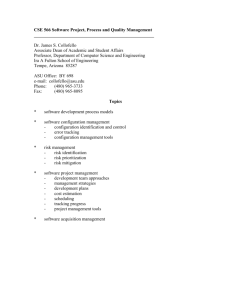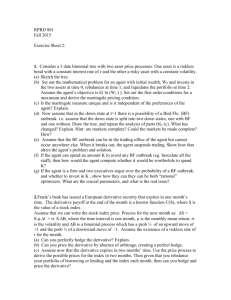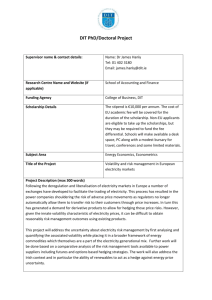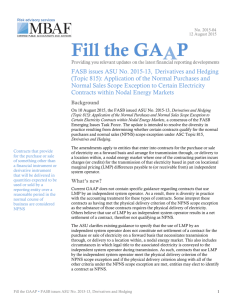Issue: ASU 2015-13 – Application of the Normal Purchases and
advertisement
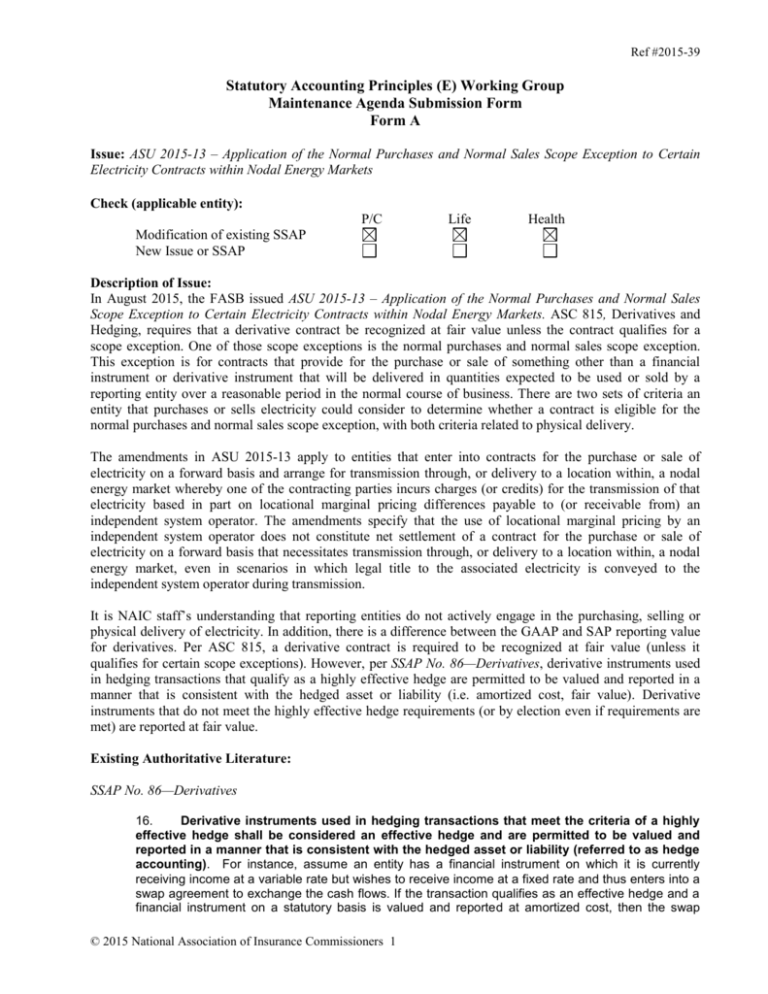
Ref #2015-39 Statutory Accounting Principles (E) Working Group Maintenance Agenda Submission Form Form A Issue: ASU 2015-13 – Application of the Normal Purchases and Normal Sales Scope Exception to Certain Electricity Contracts within Nodal Energy Markets Check (applicable entity): P/C Life Health Modification of existing SSAP New Issue or SSAP Description of Issue: In August 2015, the FASB issued ASU 2015-13 – Application of the Normal Purchases and Normal Sales Scope Exception to Certain Electricity Contracts within Nodal Energy Markets. ASC 815, Derivatives and Hedging, requires that a derivative contract be recognized at fair value unless the contract qualifies for a scope exception. One of those scope exceptions is the normal purchases and normal sales scope exception. This exception is for contracts that provide for the purchase or sale of something other than a financial instrument or derivative instrument that will be delivered in quantities expected to be used or sold by a reporting entity over a reasonable period in the normal course of business. There are two sets of criteria an entity that purchases or sells electricity could consider to determine whether a contract is eligible for the normal purchases and normal sales scope exception, with both criteria related to physical delivery. The amendments in ASU 2015-13 apply to entities that enter into contracts for the purchase or sale of electricity on a forward basis and arrange for transmission through, or delivery to a location within, a nodal energy market whereby one of the contracting parties incurs charges (or credits) for the transmission of that electricity based in part on locational marginal pricing differences payable to (or receivable from) an independent system operator. The amendments specify that the use of locational marginal pricing by an independent system operator does not constitute net settlement of a contract for the purchase or sale of electricity on a forward basis that necessitates transmission through, or delivery to a location within, a nodal energy market, even in scenarios in which legal title to the associated electricity is conveyed to the independent system operator during transmission. It is NAIC staff’s understanding that reporting entities do not actively engage in the purchasing, selling or physical delivery of electricity. In addition, there is a difference between the GAAP and SAP reporting value for derivatives. Per ASC 815, a derivative contract is required to be recognized at fair value (unless it qualifies for certain scope exceptions). However, per SSAP No. 86—Derivatives, derivative instruments used in hedging transactions that qualify as a highly effective hedge are permitted to be valued and reported in a manner that is consistent with the hedged asset or liability (i.e. amortized cost, fair value). Derivative instruments that do not meet the highly effective hedge requirements (or by election even if requirements are met) are reported at fair value. Existing Authoritative Literature: SSAP No. 86—Derivatives 16. Derivative instruments used in hedging transactions that meet the criteria of a highly effective hedge shall be considered an effective hedge and are permitted to be valued and reported in a manner that is consistent with the hedged asset or liability (referred to as hedge accounting). For instance, assume an entity has a financial instrument on which it is currently receiving income at a variable rate but wishes to receive income at a fixed rate and thus enters into a swap agreement to exchange the cash flows. If the transaction qualifies as an effective hedge and a financial instrument on a statutory basis is valued and reported at amortized cost, then the swap © 2015 National Association of Insurance Commissioners 1 Ref #2015-39 would also be valued and reported at amortized cost. Derivative instruments used in hedging transactions that do not meet or no longer meet the criteria of an effective hedge, or that meet the required criteria but the entity has chosen not to apply hedge accounting, shall be accounted for at fair value and the changes in the fair value shall be recorded as unrealized gains or unrealized losses (referred to as fair value accounting). Activity to Date (issues previously addressed by SAPWG, Emerging Accounting Issues WG, SEC, FASB, other State Departments of Insurance or other NAIC groups): None. Information or issues (included in Description of Issue) not previously contemplated by the SAPWG: None Recommendation: Staff recommends that the Working Group move this item to the nonsubstantive active listing and expose nonsubstantive revisions to Appendix D—Nonapplicable GAAP Pronouncements for Statutory Accounting to reject ASU 2015-13 as not applicable to statutory accounting. As detailed in the summary, the revised guidance within the ASU is specific to the purchasing; selling and/or physical delivery of electricity, and NAIC staff is not aware of reporting entities engaging in these activities. Furthermore, if the hedge was highly effective, reporting entities already have the option to utilize the hedge accounting method detailed in SSAP No. 86. Staff Review Completed by: Josh Arpin – August 2015 Status: On November 19, 2015, the Statutory Accounting Principles (E) Working Group moved this item to the nonsubstantive active listing and exposed this agenda item noting the intent to reject ASU 2015-13 in Appendix D as not applicable to statutory accounting. G:\DATA\Stat Acctg\3. National Meetings\A. National Meeting Materials\2015\Fall\NM Exposures\15-39 - ASU 2015-13 - Electricity Contracts within Nodal Energy Markets.docx © 2015 National Association of Insurance Commissioners 2
